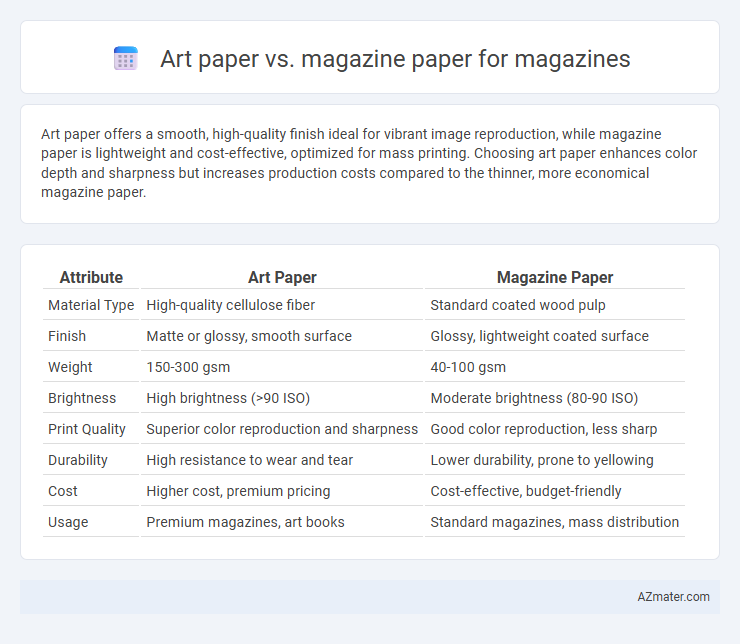Art paper offers a smooth, high-quality finish ideal for vibrant image reproduction, while magazine paper is lightweight and cost-effective, optimized for mass printing. Choosing art paper enhances color depth and sharpness but increases production costs compared to the thinner, more economical magazine paper.
Table of Comparison
| Attribute | Art Paper | Magazine Paper |
|---|---|---|
| Material Type | High-quality cellulose fiber | Standard coated wood pulp |
| Finish | Matte or glossy, smooth surface | Glossy, lightweight coated surface |
| Weight | 150-300 gsm | 40-100 gsm |
| Brightness | High brightness (>90 ISO) | Moderate brightness (80-90 ISO) |
| Print Quality | Superior color reproduction and sharpness | Good color reproduction, less sharp |
| Durability | High resistance to wear and tear | Lower durability, prone to yellowing |
| Cost | Higher cost, premium pricing | Cost-effective, budget-friendly |
| Usage | Premium magazines, art books | Standard magazines, mass distribution |
Understanding Art Paper and Magazine Paper
Art paper offers a smooth, high-quality finish with excellent color reproduction, ideal for vibrant image-heavy magazine spreads, while magazine paper typically features a lighter weight and more economical coating suitable for standard text and image layouts. Art paper's higher brightness and opacity enhance visual sharpness and reduce ink bleed, making it preferred for premium magazine editions. Magazine paper balances cost efficiency and print clarity, commonly used in mass-market publications where durability and cost control are essential.
Key Differences in Texture and Finish
Art paper for magazines offers a smooth, high-quality texture with a glossy or matte finish that enhances color vibrancy and sharpness, ideal for high-end photo reproduction. Magazine paper, often coated but lighter and less dense, features a smoother yet thinner texture designed for mass production and cost efficiency, resulting in less vivid color output. The finish on art paper tends to be more lustrous and durable, providing a premium tactile experience compared to the standard semi-gloss or matte finish typical of magazine paper.
Print Quality: Art Paper vs Magazine Paper
Art paper offers superior print quality for magazines due to its smooth, coated surface that enhances color vibrancy and sharpness, ensuring images and text appear crisp and detailed. Magazine paper, typically uncoated or lightly coated, provides a more matte finish but can result in less vivid colors and lower contrast. Choosing art paper is ideal for high-end publications where visual impact and print clarity are critical.
Color Reproduction and Vibrancy
Art paper offers superior color reproduction and vibrancy for magazines due to its smooth, coated surface that enhances ink absorption and sharpness. Magazine paper, typically uncoated or lightly coated, results in less vivid colors and lower contrast, which can diminish the impact of high-quality images. Choosing art paper significantly improves visual appeal by maintaining true-to-life color accuracy and brightness.
Durability and Longevity in Magazines
Art paper offers superior durability and longevity for magazines due to its thicker, coated surface that resists wear and tear, maintaining print quality over time. Magazine paper, typically lighter and less coated, is more prone to yellowing and damage from handling, reducing the magazine's lifespan. Choosing art paper enhances the magazine's ability to withstand frequent use while preserving vibrant images and text clarity.
Cost-Effectiveness for Publishers
Art paper offers superior print quality with vibrant colors and sharp images, making it ideal for high-end magazines but at a higher production cost. Magazine paper, typically coated but thinner and less glossy, significantly reduces expenses in bulk printing without severely compromising visual appeal, enhancing cost-effectiveness for publishers targeting a broader audience. Choosing magazine paper can optimize the balance between quality and budget, maximizing profitability in large-scale magazine production.
Environmental Impact and Sustainability
Art paper, typically made from virgin fibers and coated with clay or polymers, offers superior print quality but has a higher environmental footprint due to resource-intensive production and limited recycling options. Magazine paper, often produced with recycled content and designed for easier recyclability, supports sustainability efforts by reducing deforestation and lowering energy consumption during manufacturing. Choosing magazine paper enhances eco-friendly publishing by minimizing waste and promoting circular economy practices in the print industry.
Reader Experience and Perception
Art paper offers a smooth, high-quality surface that enhances color vibrancy and sharpness, providing readers with a more immersive visual experience in magazines. Magazine paper, being lighter and less glossy, often results in muted colors and reduced image definition, which can affect the perceived value and professionalism of the publication. Reader perception tends to favor magazines printed on art paper due to its premium feel and superior print quality, contributing to increased engagement and brand credibility.
Common Applications in the Magazine Industry
Art paper, known for its smooth texture and high brightness, is frequently used in magazines showcasing high-quality photography, fashion spreads, and art portfolios due to its excellent color reproduction and sharp image clarity. Magazine paper, typically coated with a glossy or matte finish and designed for cost-effectiveness, is common in general-interest magazines, lifestyle publications, and catalogs where vibrant images and durability are essential but budget constraints exist. Both paper types support various printing techniques such as offset and digital printing, catering to diverse magazine industry needs ranging from luxury editions to mass-market publications.
Choosing the Right Paper for Your Magazine
Art paper offers a smooth, high-quality finish ideal for vibrant photo reproduction and premium magazine aesthetics, while magazine paper, often coated and lightweight, balances cost-efficiency with acceptable print quality. Selecting the right paper depends on the magazine's purpose: art paper suits luxury publications emphasizing sharp image clarity, whereas magazine paper is practical for high-volume, budget-friendly runs. Consider factors like durability, print vibrancy, and budget constraints to ensure the chosen paper aligns with the magazine's visual impact and distribution goals.

Infographic: Art paper vs Magazine paper for Magazine
 azmater.com
azmater.com